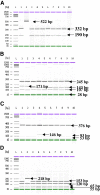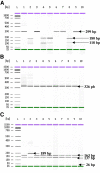High prevalence of mutation in the Plasmodium falciparum dhfr and dhps genes in field isolates from Sabah, Northern Borneo
- PMID: 23758930
- PMCID: PMC3706343
- DOI: 10.1186/1475-2875-12-198
High prevalence of mutation in the Plasmodium falciparum dhfr and dhps genes in field isolates from Sabah, Northern Borneo
Abstract
Background: Sulphadoxine-pyrimethamine (SP) has been in use for the treatment of uncomplicated falciparum malaria in Malaysia since the 1970s and is still widely employed in spite of widespread clinical resistance. Resistance to SP is known to be mediated by mutations in the pfdhfr and pfdhps genes. The aim of the present study was to investigate the distribution of pfdhfr and pfdhps gene polymorphism in Plasmodium falciparum field isolates from Kalabakan, Sabah, in northern Borneo.
Methods: A total number of 619 individuals were screened from 23 study sites of which 31 were positive for P. falciparum. Analysis of restriction fragment length polymorphisms (RFLP) was used to identify polymorphism in the pfdhfr and pfdhps genes at positions 16, 51, 59, 108, 164 and 437, 540, 581, respectively.
Results: All samples had at least one mutation in each of the genes associated with drug resistance. The prevalence of pfdhfr 59arg, 164leu and 108asn were 100%, 80.65% and 58.06%, respectively. Pfdhps mutants 437gly and 581gly accounted for 100% and 74.19% respectively. In pfdhfr, the most common mutant genotypes were combination 59arg + 164leu (22.58%) and 59arg + 108asn + 164leu (51.61%). In pfdhps the most common genotype was 437gly + 581gly (74.19%). One individual (3.22%) harboured parasites with four pfdhfr (16 val + 59arg + 108asn + 164leu) and two pfdhps (437gly + 581gly) mutations. The highest quintuple pfdhfr/pfdhps (41.94%) was three pfdhfr (59arg + 108asn + 164gly) and two pfdhps (437gly + 581gly).
Conclusion: The data suggest a high prevalence of genetic variations conferring resistance to SP which can predict treatment failure before becoming clinically evident. In areas like this, the use of SP may no longer be indicated.
Figures



References
-
- Rundi C. Malaria Elimination in Malaysia. Kota Kinabalu, Sabah Malaysia: Ministry of Health Malaysia; 2011. (Third annual meeting of the Asia Pacific Malaria Elimination Network (APMEN)).
-
- WHO. Roll Back Malaria 2005. Geneva: World Health Organization; 2005.
-
- Rahman H. Updates on Malaria Control Activities in Malaysia. Brisbane, Australia: Ministry of Health Malaysia; 2009. (First annual meeting of the Asia Pacific Malaria Elimination Network (APMEN)).
-
- Kheong CC. Country Updates: Malaysia. Luang Prabang, Lao PDR: Ministry of Health Malaysia; 2010. (Asian Collaborative Training Network for Malaria (ACT Malaria) Executive Board Meeting; 15–17 March 2010).
-
- Dondorp AM, Nosten F, Yi P, Das D, Phyo AP, Tarning J, Lwin KM, Ariey F, Hanpithakpong W, Lee SJ, Ringwald P, Silamut K, Imwong M, Chotivanich K, Lim P, Herdman T, An SS, Yeung S, Singhasivanon P, Day NP, Lindegardh N, Socheat D, White NJ. Artemisinin resistance in Plasmodium falciparum malaria. N Engl J Med. 2009;361:455–467. doi: 10.1056/NEJMoa0808859. - DOI - PMC - PubMed
Publication types
MeSH terms
Substances
LinkOut - more resources
Full Text Sources
Other Literature Sources

